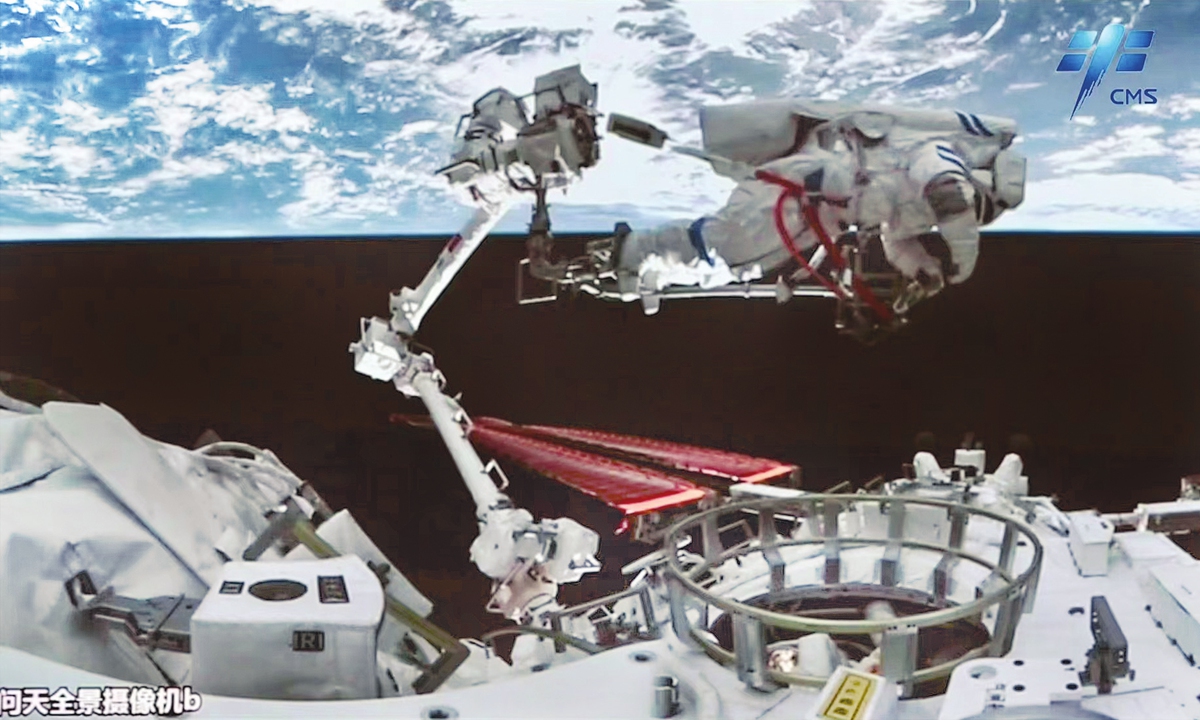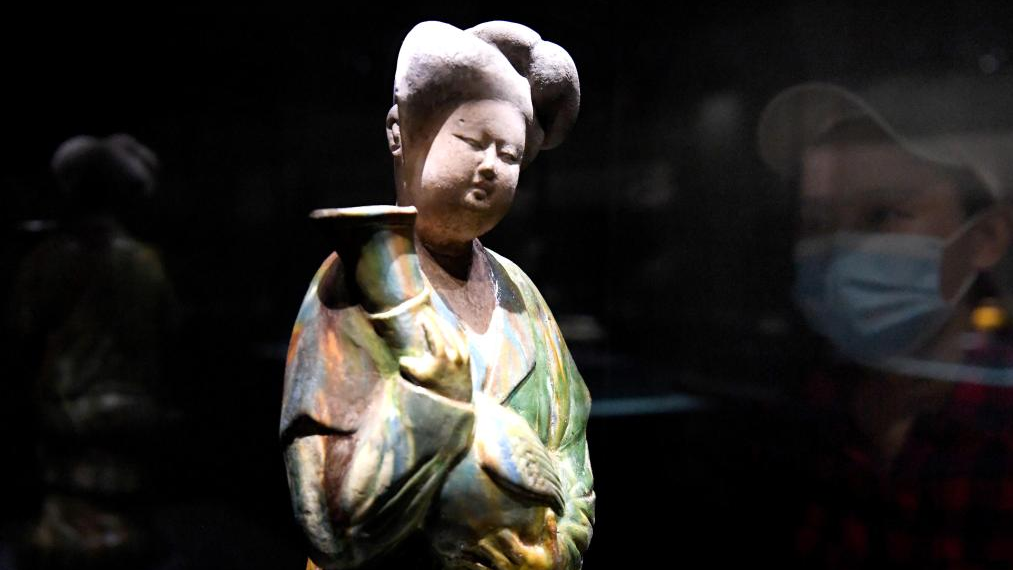Shenzhou-14 crew completes 1st spacewalk mission; China's extravehicular tech 'more mature and task-oriented'

Shenzhou-14 taikonauts conduct extravehicular activities on September 1, 2022 for the first time since entering the Wentian lab module on July 25, 2022. Photo: courtesy of the China Manned Space Agency
Having moved into China's space home for nearly three months, the Shenzhou-14 crew smoothly conducted its first extravehicular activity on Thursday, the China Manned Space Agency (CMSA) said. The entire process took about six hours, and it was the first time that taikonauts ventured out through the airlock cabin in the Wentian lab module, which just arrived at the space station about a month ago.
Mission commander of Shenzhou-14 Chen Dong and crew member Liu Yang were assigned to conduct the spacewalk mission this time, while their teammate Cai Xuzhe was responsible for various support work inside the cabin, state media China Central Television reported.
They began preparing for their exit wearing spacesuits at 3:48 pm on Thursday, and at 7 pm, the two successfully moved out of the cabin. Together, Chen and Liu completed the installation of the extended pump set of the Wentian and the lifting of the panoramic camera, as well as other tasks with the help of the small robotic arm, and carried out emergency return capability verification.
Unlike previous times when the Shenzhou-12 and -13 crews exited the space station through the Tianhe core cabin, the Shenzhou-14 crew for the first time ventured out through the airlock cabin in the Wentian lab module, which just arrived at the space station on July 25.
The node cabin for the taikonauts' exit in the Tianhe has a gate width of 85 centimeters, while the airlock cabin in the Wentian is one meter wide, allowing taikonauts with space suits on and equipment in hand to walk more "freely" into space, developer and manufacturer of the cabin the China Academy of Space Technology (CAST) said in a statement it sent to the Global Times.
Therefore, the airlock cabin of the Wentian will become the main exit-entry point for extravehicular activities, while the previous one in the Tianhe will serve as backup. The two exit-entry cabins will greatly boost the reliability and better ensure the safety of taikonauts in case of an emergency during extravehicular work, according to Li Jinlin, a chief designer of extravehicular suits at the Astronaut System at the China Manned Space Agency.
Exiting from the Wentian lab module instead of the Tianhe means that the taikonauts must take different routes and that requires a number of technical adjustments, Wang Ya'nan, chief editor of Beijing-based Aerospace Knowledge magazine, told the Global Times on Thursday. The successful mission has verified the feasibility of using the Wentian as the main exit-entry gate, experts noted.
Thursday's mission also verified the functions of the five-meter-long small robotic arm installed outside the airlock cabin. With seven degrees of freedom, the set has a higher precision and flexibility to "grasp" small and medium-sized pieces of equipment, and is capable of more delicate operations than the bigger robotic arm with the Tianhe module.
During the construction stage of the space station, taikonauts have to complete equipment installation, maintenance and other tasks outside the cabin. With a greater range of movement needed for a more challenging extravehicular activity, safety requirements have also become more stringent.
Therefore, research teams have developed a longer and retractable safety rope, allowing more than 10 meters of connection between the taikonauts and the module. This will not only pose little interference to spacesuits or the movement of the taikonauts, but will also withstand the test of the space environment with a 200 C temperature gap, space irradiation and other harsh conditions, the CAST noted.
Over more than three years, ground research teams have independently developed 238 outboard maintenance tools in 36 categories for the core module and the Wentian lab module, with a total weight of 509 kilograms, it added.
Another highlight of Thursday's mission is the support of domestically developed high-end aerospace chips. Considered as the cells and even the heart of a spacecraft, China has made major progresses in increasing their quality and quantity, in the face of a crackdown by the US.
On Wednesday, US chip designer Nvidia Corp said that the US government told the company to stop exporting two top computing chips for artificial intelligence work to China, reported Reuters.
China has been making steady progress in planning extravehicular activities. The first batch of taikonauts entering the Tianhe, the Shenzhou-12 crew, carried out one spacewalk mission, while for their successor, the Shenzhou-13 crew, two missions were successfully completed. The Shenzhou-14 squad is expected to conduct two to three spacewalk missions.
Experts said that compared with previous times, which were more focused on technology verification, Shenzhou-14's extravehicular activities are more task-oriented.
With extravehicular activity becoming more regular, related technologies have also become more mature. The Shenzhou-12 and -13 missions were mainly for technical verification but now with the Shenzhou-14, these technologies will enter the application stage, as our Wentian module has arrived, and a lot of basic work needs to be done, Song Zhongping, a TV commentator who closely follows China's space program, told the Global Times on Thursday.
"Meanwhile, a large amount of preparation work is also needed for the upcoming Mengtian launch and docking, so now we are following the actual needs of building the space station to arrange extravehicular activities, and that's very different from the previous mission," Song said.
Since they arrived at China's space station on June 5, the three crew members of Shenzhou-14 have spent 88 days in orbit. They have completed multiple tasks including the transfer of materials from the cargo spacecraft, in-orbit testing of the Wentian lab module, unlocking the science experiment cabinets, functional tests of the small robotic arm, and the management of the space station assembly, according to the CMSA.
Photos
Related Stories
- Shenzhou-14 astronauts enter Wentian lab module
- Shenzhou-14 astronauts enter Wentian lab module
- China develops new coating for spacecraft thermal control
- Highlights of Shenzhou-14 Mission
- China's Shenzhou-14 crewed spaceship docks with space station combination
- See-off ceremony held for Chinese astronauts of Shenzhou-14 mission
Copyright © 2022 People's Daily Online. All Rights Reserved.









